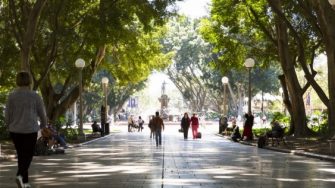Leafier communities, healthier hearts: study
Urban green space reduces cardiovascular disease risk, and more trees are key.
Urban green space reduces cardiovascular disease risk, and more trees are key.

A walk in the park a day, keeps the doctor away… A new study from UNSW Sydney, published in Heart, Lung and Circulation, shows how different types of urban green space impact cardiovascular health.
Previous studies demonstrate that nearby green space reduces risk of cardiovascular disease by promoting physical activity, reducing stress, and mitigating excess heat and air pollution. High quality green spaces can also reduce loneliness, which then also benefits heart health. However, there is little understanding of which types of green space, for example tree cover or grassy open areas, are important.
This research was led by Professor Xiaoqi Feng from UNSW and Professor Thomas Astell-Burt from the University of Wollongong, who are the Co-Directors of the Population Wellbeing and Environment Research Lab (PowerLab). The study involved over 100,000 Australian adults living in apartments or houses, analysing the nearby green space as well as 10 years of hospitalisation and death data.
“We were interested in where Australians are living… and what type and quantity of green space may have impact on people’s hearts,” said Prof. Feng, who is also an Honorary Professorial Fellow at The George Institute for Global Health.
The study found that for those living in houses, green space was associated with a lower risk of heart disease-related mortality. However, not all green space was equally beneficial – larger amounts of tree canopy, but not open grass, was associated with these positive health effects.
“We find that people living in houses are more likely to benefit from living closer to trees and tree canopies – for their heart in particular,” Prof. Feng said. “This could reduce the risk of developing heart attack and heart disease related mortality.”
Read more: What makes a great footpath? The answer is key to our happiness and wellbeing as we age
Why are trees more beneficial to our health? The study’s authors have several theories. For example, trees provide shade and cooler temperatures which make streets and parks more inviting to spend time in.
Interestingly, for those living in apartments, green space wasn’t associated with better cardiovascular health outcomes. Again, the study authors say there may be a few possible reasons, but more research in this area is needed.
“One reason is that apartments are normally quite dense and may be even crowded. So you can imagine that if you plant the same number of trees in a low density area and then a high density area, the ratio of trees to people changes,” Prof. Feng said.
“Also, even if there is some green space within or around your apartment block, it’s often not an area you can or would want to visit, or permit children to play in. It’s there to tick a box but offers few qualities to attract people to spend time there.”
Awareness is growing worldwide about the health impacts of green space. In countries like the US and Canada, increasing numbers of healthcare professionals are encouraging their patients to spend time in nature, otherwise known as ‘park prescriptions’.
Green space is also more important than ever in urban planning, with the major issues of climate change and city crowding. In 2021, Prof. Feng’s research informed the City of Sydney’s $377 million strategy to plant 700 new trees annually for 10 years and reach 40 per cent green cover by 2050.
Read more: 1 in 4 Australians is lonely. Quality green spaces in our cities offer a solution
“This research is important for Australia, with the massive urbanisation we can see in Sydney and Melbourne, and worldwide… We should learn more about what type and quality of green space we should have around every apartment block, to ensure everyone has opportunity to benefit from nature,” Prof. Feng said.
“We need to make sure our urban planning complements existing trees and enhances green space qualities with community input, to enable current and future generations to thrive.”
Professor Xiaoqi Feng is a population health researcher at UNSW Medicine & Health and Honorary Professorial Fellow at The George Institute for Global Health. Photo: UNSW.